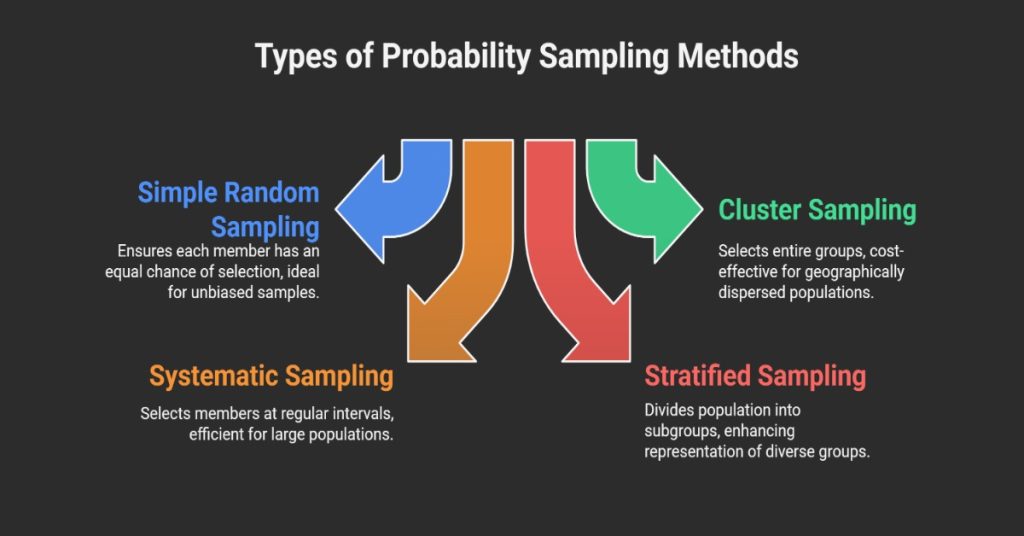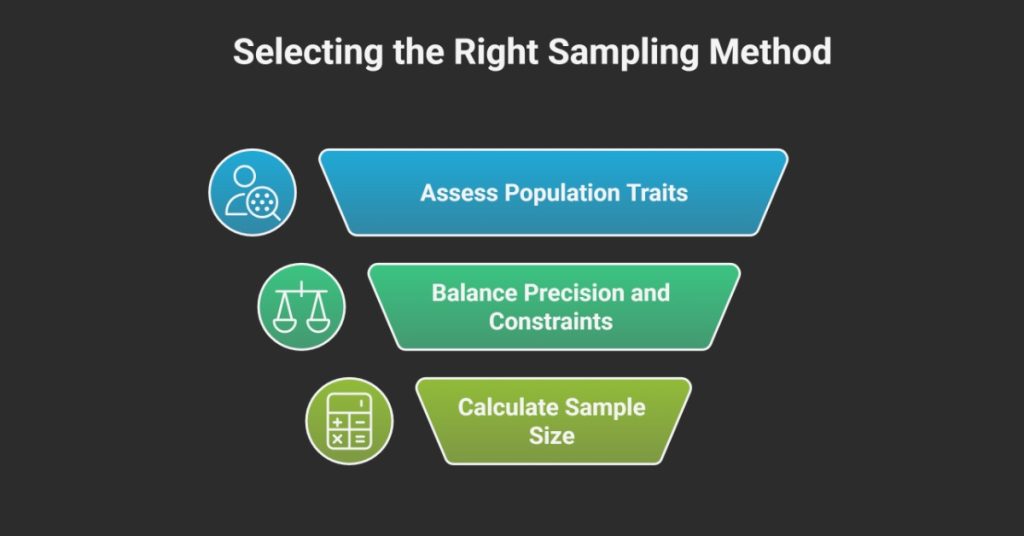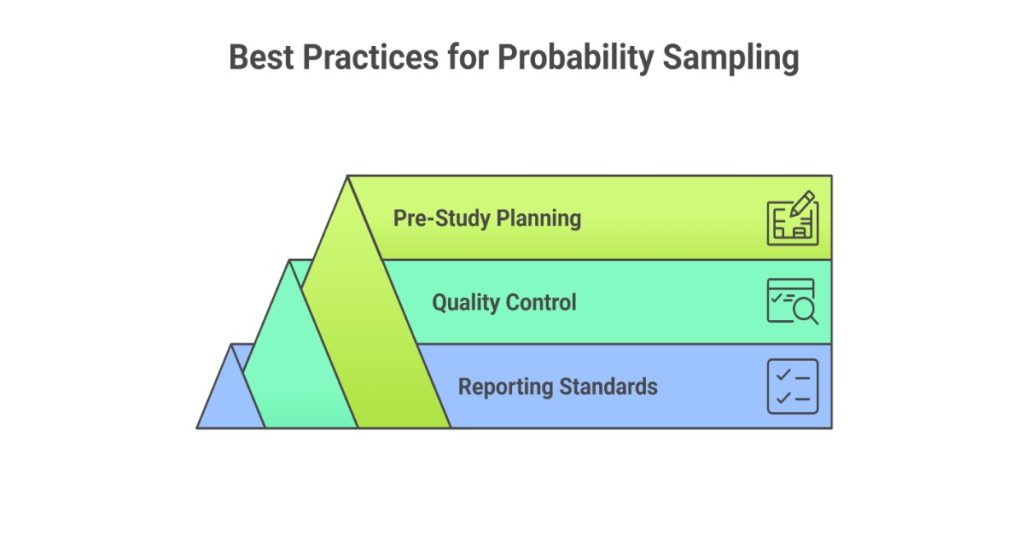Research accuracy depends heavily on how you select your sample. When conducting studies, surveys, or experiments, the sampling method you choose can make or break your findings’ validity and reliability.
Probability sampling stands as the gold standard in research methodology. It ensures every member of your target population has a known, non-zero chance of being selected for your study.
Table of Contents
What Is Probability Sampling and Why Does It Matter?
Probability sampling refers to selection techniques where researchers can calculate the likelihood of any population member being chosen. Unlike non-probability methods, these approaches eliminate selection bias and enable statistical inference.
The foundation of probability sampling lies in randomization. Every unit in your population must have an equal or calculable probability of selection.
This systematic approach allows researchers to generalize findings from their sample to the broader population with measurable confidence levels. Without probability sampling, your research conclusions remain limited to your specific sample group.
The Four Core Types of Probability Sampling Methods
1. Simple Random Sampling: The Foundation Method
Simple random sampling represents the most straightforward probability technique. Researchers assign numbers to every population member, then use random selection methods to choose participants.
Think of it like drawing names from a hat. Each person has exactly the same chance of being selected, regardless of their characteristics or position in the population.
This method works best with homogeneous populations where demographic variations are minimal. However, it requires a complete list of all population members, which isn’t always feasible for large-scale studies.
2. Systematic Sampling: Efficiency Meets Randomness
Systematic sampling combines randomness with operational efficiency. Researchers select every nth member from a ordered population list, starting with a randomly chosen initial point.
For example, if you need 100 participants from a population of 1,000, you’d select every 10th person after randomly choosing your starting position between 1 and 10.
This method works exceptionally well when your population list follows a random or neutral order. However, be cautious of periodic patterns that might introduce bias into your selection process.
3. Stratified Sampling: Precision Through Population Segments
Stratified sampling divides your population into distinct subgroups (strata) based on relevant characteristics. Then, you randomly sample from each stratum proportionally or equally.
Common stratification variables include age groups, income levels, educational backgrounds, or geographic regions. This approach ensures adequate representation of all population segments.
Proportional stratified sampling maintains each stratum’s original population proportion in your sample. Disproportional stratified sampling deliberately over-samples smaller but important subgroups for more detailed analysis.
4. Cluster Sampling: Managing Large-Scale Research Challenges
Cluster sampling addresses practical constraints when studying geographically dispersed or large populations. Researchers divide the population into clusters, then randomly select entire clusters for study.
Primary clusters might be cities, schools, or neighborhoods. Secondary clusters could involve classrooms within selected schools or households within chosen neighborhoods.
This method significantly reduces research costs and logistical complexity. However, it typically produces larger sampling errors compared to other probability methods due to within-cluster similarities.

Advanced Probability Sampling Techniques
Multi-Stage Sampling: Combining Methods for Complex Populations
Multi-stage sampling combines different probability techniques across multiple selection phases. Large-scale national surveys frequently employ this approach for practical feasibility.
The first stage might involve randomly selecting states or regions. The second stage could randomly choose cities within selected regions. The final stage might randomly select households within chosen cities.
Each stage maintains probability principles while managing the complexity of massive population studies. This flexibility makes multi-stage sampling invaluable for government surveys and large-scale market research.
Probability Proportional to Size (PPS) Sampling
PPS sampling adjusts selection probabilities based on cluster sizes or importance measures. Larger clusters receive higher selection probabilities, while smaller ones have correspondingly lower chances.
This technique proves particularly useful when cluster sizes vary dramatically. It ensures your sample adequately represents both large urban areas and smaller rural communities.
PPS sampling requires accurate size information for all clusters before selection begins. The additional complexity pays off through improved representativeness and reduced sampling variance.
How to Choose the Right Probability Sampling Method
1. Assessing Your Population Characteristics
Your population’s structure directly influences which sampling method works best. Homogeneous populations suit simple random sampling, while diverse populations benefit from stratified approaches.
Geographic distribution matters significantly. Concentrated populations allow for simple or systematic sampling, while dispersed populations often require cluster-based methods.
Population size affects both feasibility and cost considerations. Smaller populations might permit complete enumeration, while larger ones demand more sophisticated sampling strategies.
2. Balancing Precision and Practical Constraints
Research budgets and timelines impose real-world limitations on sampling choices. Simple random sampling offers theoretical purity but might prove too expensive for large populations.
Cluster sampling reduces costs but increases sampling error. Stratified sampling improves precision but requires detailed population knowledge and more complex analysis.
Consider your acceptable margin of error when choosing methods. Higher precision requirements might justify more expensive sampling approaches.
3. Sample Size Calculations and Power Analysis
Proper sample size calculation ensures adequate statistical power while avoiding unnecessary costs. Different sampling methods require different calculation approaches.
Simple random sampling uses straightforward formulas based on population variance and desired precision. Stratified sampling requires separate calculations for each stratum.
Cluster sampling involves design effects that inflate required sample sizes. Multi-stage sampling compounds these effects across multiple selection phases.

Common Mistakes in Probability Sampling Implementation
1. Frame Problems and Coverage Issues
Sampling frame quality directly affects your results’ validity. Incomplete frames exclude population segments, creating coverage bias that probability methods cannot correct.
Outdated frames include individuals no longer in your target population while missing recent additions. Regular frame updates are essential for maintaining sampling integrity.
Multiple frames sometimes cover the same population differently. Reconciling these differences requires careful planning and potentially more complex sampling designs.
2. Selection Bias Despite Random Methods
Even probability sampling can introduce bias through implementation errors. Non-response bias occurs when selected participants systematically refuse to participate.
Interviewer bias emerges when data collectors unconsciously influence participant selection or responses. Standardized protocols and training help minimize these effects.
Timing bias affects studies where selection occurs during specific periods. Seasonal variations or current events might skew your sample composition.
3. Statistical Analysis Errors
Different sampling methods require specific statistical techniques. Treating cluster samples as simple random samples underestimates standard errors and inflates significance levels.
Stratified samples need weighted analysis to properly represent population proportions. Ignoring stratification wastes the precision gains this method provides.
Multi-stage samples require complex variance estimation procedures. Standard statistical software might not automatically account for design effects.
People Also Ask: Essential Probability Sampling Questions
What’s the Difference Between Probability and Non-Probability Sampling?
Probability sampling gives every population member a known, calculable chance of selection. Non-probability sampling relies on researcher judgment, convenience, or volunteer participation.
Probability methods enable statistical inference and generalization to broader populations. Non-probability approaches limit conclusions to the specific sample studied.
The choice depends on your research objectives, available resources, and required level of statistical rigor. Exploratory studies might accept non-probability methods, while confirmatory research demands probability approaches.
How Do You Calculate Sample Size for Different Probability Methods?
Sample size calculations vary significantly across probability sampling methods. Simple random sampling uses population variance, desired precision, and confidence level in straightforward formulas.
Stratified sampling requires separate calculations for each stratum, then combines them based on allocation strategies. Proportional allocation maintains population proportions, while optimal allocation minimizes variance.
Cluster sampling involves design effects that multiply basic sample size requirements. These effects depend on within-cluster correlation and cluster size variations.

When Should You Use Stratified vs. Cluster Sampling?
Stratified sampling works best when you can easily identify and separate distinct population subgroups. It’s ideal when subgroup differences are important to your research questions.
Cluster sampling suits geographically dispersed populations or situations where individual-level sampling proves impractical. It’s cost-effective for large-scale studies covering wide areas.
Consider stratified sampling when population heterogeneity is high and you need precise subgroup estimates. Choose cluster sampling when logistical constraints outweigh precision concerns.
What Are the Main Advantages of Probability Sampling?
Probability sampling enables unbiased population estimates with measurable precision. You can calculate confidence intervals and conduct hypothesis tests with known error probabilities.
These methods eliminate researcher selection bias and provide defendable scientific results. External validity allows generalization beyond your specific sample to broader populations.
Probability sampling also enables replication and comparison across different studies. Standardized methods facilitate meta-analyses and systematic reviews.
How Do You Handle Non-Response in Probability Samples?
Non-response threatens probability sampling validity by potentially creating systematic bias. High response rates minimize this concern, but achieving them requires careful planning.
Multiple contact attempts, incentives, and varied communication methods help maximize participation. However, these strategies increase research costs and timeline requirements.
Post-survey adjustments can partially compensate for non-response bias. Weighting adjustments and imputation techniques help maintain sample representativeness, though they cannot completely eliminate potential bias.
Best Practices for Implementing Probability Sampling
1. Pre-Study Planning and Design Considerations
Thorough planning prevents costly mistakes and methodological problems. Define your target population precisely before selecting sampling methods.
Evaluate available sampling frames for completeness and accuracy. Multiple frames might provide better coverage than single sources.
Pilot testing reveals practical implementation challenges before full-scale data collection begins. Small-scale trials help refine procedures and identify potential problems.
2. Quality Control Throughout the Sampling Process
Document every step of your sampling procedure for transparency and replication. Maintain detailed records of selection methods, response rates, and any deviations from planned procedures.
Regular monitoring during data collection helps identify emerging problems before they compromise your entire study. Quick adjustments can prevent systematic errors.
Post-collection analysis should examine sample characteristics against known population parameters. Significant deviations might indicate implementation problems requiring investigation.
3. Reporting and Documentation Standards
Comprehensive reporting enables readers to evaluate your sampling methodology’s appropriateness and quality. Include sufficient detail for replication by other researchers.
Report actual response rates, not just planned sample sizes. Discuss how non-response might affect your findings and what steps you took to minimize bias.
Acknowledge sampling limitations honestly. No method is perfect, and transparency about constraints strengthens rather than weakens your research credibility.

The Future of Probability Sampling in Research
Technology’s Impact on Sampling Methods
Digital data sources are revolutionizing sampling frame construction and maintenance. Online platforms provide real-time population information previously impossible to obtain.
Mobile devices enable location-based sampling and reduce geographic constraints on data collection. However, digital divides might exclude certain population segments from technology-based frames.
Artificial intelligence helps optimize sampling designs and detect potential bias sources. Machine learning algorithms can identify subtle patterns that human researchers might miss.
Emerging Challenges and Opportunities
Declining survey participation rates challenge traditional probability sampling effectiveness. Researchers must develop new engagement strategies and potentially accept lower response rates.
Privacy concerns limit access to traditional sampling frames. Regulatory changes affect how researchers can identify and contact potential participants.
Mixed-mode data collection combines multiple communication channels to maximize participation. However, mode effects might introduce new sources of bias requiring careful analysis.
Read More
Snowball Sampling: What It Is, Uses & Key Benefits
Cluster Sampling: A Guide to Advantages & Disadvantages with Examples
Data Collection Methods: A Complete Guide to Qualitative, Quantitative & Mixed Techniques
Conclusion: Making Informed Sampling Decisions
Probability sampling remains essential for rigorous research despite evolving challenges. The method you choose should align with your research objectives, population characteristics, and practical constraints.
Understanding each technique’s strengths and limitations helps you make informed decisions. No single method works optimally for every research situation.
Success depends on careful planning, rigorous implementation, and honest reporting of limitations. When executed properly, probability sampling provides the foundation for credible, generalizable research findings that advance knowledge and inform decision-making.
The investment in proper probability sampling pays dividends through increased confidence in your results and broader acceptance of your findings by the scientific community and stakeholders.

